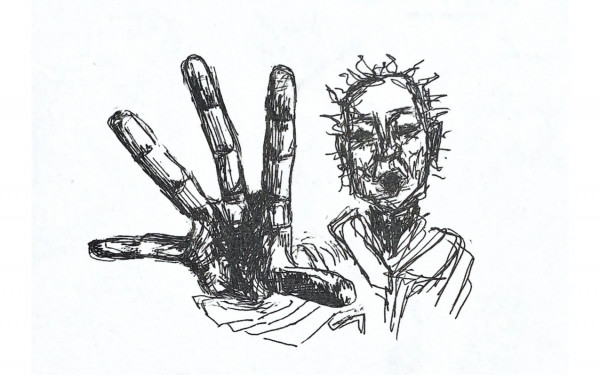Women, weed and wellness
The gender-based dynamics of cannabis-induced anxiety
Three years ago, Ruby Burns got high for the first time. She smoked from a bong in her older cousin’s bedroom.
“God, that was awful,” she remembers. “I couldn’t feel my mouth, but I was laughing and laughing. And then I was like, ‘Oh, I can’t feel my lungs — How am I breathing?’ And then, ‘I’m not breathing.’”
Burns is 19 now, and recalling the memory still shakes her from an otherwise laid-back composure. “I was still laughing while this is all happening, but I was just panicking. My vision literally closed in like a little black tunnel,” she adds.
She didn’t wake up until a minute later.
“My senses slowly, slowly, slowly started to come back and I realized that I was literally just shrieking. I was screaming and I didn’t even know ‘cause I was blacked out,” Burns says. This was her first of many brushes with cannabis-induced anxiety.
Popular depiction has built cannabis a reputation as the world’s most relaxed drug. However, this is far from a universal truth.
According to a University of Ottawa study, 27 per cent of users who visit the emergency department develop a new anxiety disorder within three years. Yet, very little research has been conducted on anxiety episodes which did not result in a hospital visit. Therefore, it’s unknown exactly how common an issue cannabis induced anxiety is.
In 2017, Dr. Susan A. Stoner published a literature review on cannabis and anxiety through the University of Washington and the Alcohol and Drug Abuse Institute. Stoner found cannabis-induced anxiety to be more common when associated with several factors: Consumption in high doses, strains potent with the chemical THC and low in CBD, existing psychiatric disorders, infrequent use, unpleasant settings or contexts and consumption by females.
Stoner’s final point about the consumption of cannabis by females begs a few questions. Does sex influence the brain’s response to cannabis? Are men less likely to report experiences of anxiety? Or is it something else entirely?
If you’re to believe the stereotypes, Holly Hager looks more like the lawyer cracking down on a major cannabis player than actually being a major cannabis player herself – that’s sort of the point. Impeccably stylish and articulate, Hager is the COO and co-founder of House of Puff, a “cosmopolitan lifestyle brand inspired by today’s high-functioning woman.”
Hager says her business partner, Kristina Lopez Adduci, first dreamt up House of Puff when she began using cannabis as a treatment for her anxiety.
“[Adduci had] tried all the anti-anxiety medications, and they weren’t working for her,” says Hager. She says the effects of cannabis quickly reduced Adduci’s anxiety, but she was deterred from cannabis because she didn’t feel represented in its world.
Hager believes one reason that so many women react poorly to cannabis is that the context of consumption is often intimidating. Surveys by the National Center for Biotechnology Information and Statistics Canada have found that cannabis consumption remains a male-dominated space. Additionally, a Harris Poll study for the cannabis retailer Med Men found that 65 per cent of female cannabis users feel the need to hide their consumption.
“A gross, dirty bong can be scary,” Adduci says, as can the stigma that many female users still feel.
Hager, who uses cannabis daily to treat anxiety and the symptoms of an autoimmune disorder, says the first step to avoiding a negative response is research.
She recommends potential users research terpenes, the compounds that illicit different effects in each strain of cannabis. She looks for strains with myrcene, a calming terpene found in strains such as Pineapple Express, OG Kush, and the Haze family. Hager also says that strains with a higher content of the chemical CBD are less likely to cause anxiety. This research can be conducted on databases like Leafy, or through conversations with a “budtender” at a dispensary.
Hager suggests beginning with a low dose, such as a two-and-a-half milligram THC beverage, and gradually increasing the dose over several sessions. “If it is a strain or a formulation that makes you anxious, you don’t want to have a lot of it and figure that out,” she advises.
She also points out that different methods of consumption can widely change the cannabis experience. “By choosing a form factor that’s not inhalation, that’s going to reduce any worries about hurting your health,” she says. She recommends sublinguals as a discreet method for public consumption, where fear of judgment can be anxiety-inducing. Hager says safety and comfort are the keys to a good experience.
“Have you ever had little shadow guys in the corners of your eyes?” Callista Pitman asks. Pitman, who recently withdrew from McGill psychology, suffers from borderline personality disorder.
“[The disorder is] the borderline between psychosis and neurosis,” she says. “And what weed does is it pushes you over the edge.” She says cannabis is recreationally used to produce desirable psychotic effects, but in her case, it could trigger a long-term psychotic episode. The shadows she’s seen when she’s smoked too much, a common hallucination for patients experiencing psychosis, could stick around for good.
Pitman says the information psychiatrists provide on drug interactions with mental illnesses is limited. Instead, patients are simply told to avoid drug use altogether. “It’s like teaching abstinence in schools, it doesn’t work,” Pitman says.
Instead, Pitman believes nuanced and effective drug education is only provided once drug use becomes a problem. “No one’s going to teach a teenager who’s never done drugs before about harm reduction, because it’s seen as encouraging instead of educating someone,” she says.
Pitman says that, had she only been educated on the subject in treatment, she likely would have put her mental health in further jeopardy. “I haven’t done psychedelics, but honestly if I wasn’t a psych[ology] student I probably would have,” she says.
The most important asset in reducing the risks of cannabis-induced anxiety, or worse, is information, Hager says. She emphasizes that better understanding the drug, the user and their interaction will universally improve the cannabis experience, but says this is impossible without gathering further information.
“To get the real effect that you want to feel, to get the relaxation without any anxiety,” adds Hager, “you have to do some research.”
This article originally appeared in Volume 44, Issue 11, published March 5, 2024.





_600_375_90_s_c1.jpg)
